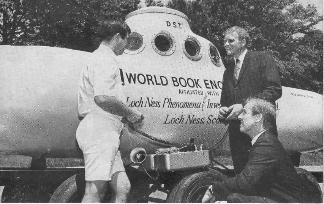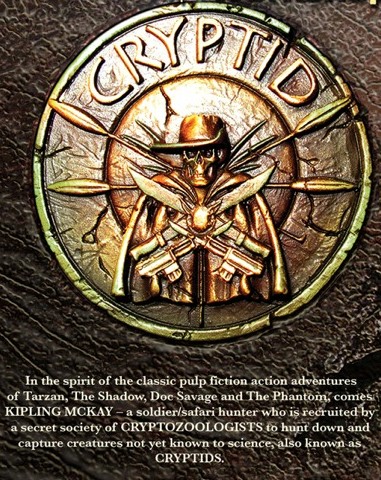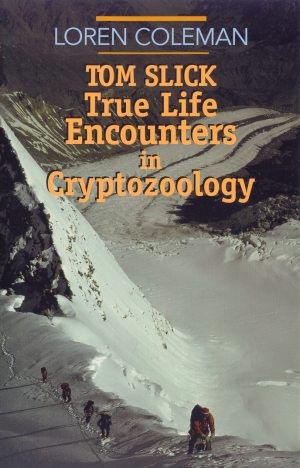How Big is the Cryptozoology Community?
Posted by: Loren Coleman on July 19th, 2007

My late friend, colleague, and mentor, Ivan T. Sanderson, shown above with a lemur in his private zoo, was one of the first in America to try to organize those interested in cryptozoology into a formal “society.” What does his legacy look like today?
Matt Bille asked me a simple question: “How big is the cryptozoological community?”
Specifically, Matt wanted to know if anyone has tried to estimate the size of the cryptozoological community – that is, the number of people in North America particularly, who actively follow cryptozoological news and publications? How many people, Matt wondered, actually spend time following the subject?
Of course, no one knows, for certain, but I thought I would open the question here, by recording some historic highlights from my memory, and asking you what you think.
Several people, especially marketing people with magazines and publishers, often ask me and others these types of questions. Thus, I have, of course, tried to come up with some reasonable estimates. But estimates are all that exist. Still, that hasn’t stopped some of us from making guesstimates.
The steady climb from the very few people interested in Sea Serpents and Yeti in the 1950s, began with the “new age” of Sasquatch in the 1940s and early 1950s in Canada, then of Bigfoot in 1958 and 1967. The visible image of the Patterson-Gimlin footage had iconic symbolism for those that began to put a meaning to a new word from the late 1950s – “cryptozoology.”
In 1969, when Ivan T. Sanderson and I had an extended exchange about the number of those actively interested in cryptozoology, we figured the number was under 15 people doing serious research in the USA, which included those interested in Bigfoot in the eastern USA being about five people, and those in the PNW (northern California up to British Columbia) being only 30 souls. How many people followed what was happening? Very few.
Sanderson joked with me that he thought the dominant force studying the situation was the Russians. He might have been correct, followed by the French.

But things were slowly changing. During the early 1970s, I had about 400 mail (remember snail mail?) correspondents, which included Bigfoot, Nessie, cryptozoology, and Fortean enthusiasts. Sanderson’s Society of the Investigation of the Unexplained never had much more than 500 members. Sanderson died in 1973, and SITU limped along barely surviving after this death, for only a few years.
In the early 1980s, I recall talking to colleagues about this topic again, and noting maybe 500 to 700 people in North America were actively following cryptozoology and Bigfoot research (intensively to very casually), with maybe less than 100 active researchers out in the field, in the libraries, and writing. One could count on one hand the authors of note in the 1980s.
Created in 1982, and lasting a little over a decade, the International Society of Cryptozoology (ISC) never reached a membership that gave it financial security. As Jerome Clark noted in his 1993 book, Encyclopedia of Strange and Unexplained Physical Phenomena, the ISC’s magical money mark – 1000 members – always eluded it. When Clark wrote his entry in the early 1990s, the ISC membership was at about 850. This can be compared to Clark’s number for the International Fortean Organization of a little less than 800 members, also mentioned in his 1993 Encyclopedia.
Throughout the early 1990s, cable television began to build a screening room of documentaries, programming, and specials about cryptozoology, with the two favorites, Bigfoot and Nessie, creating many new fans. People would see the shows, and began searching out more to read about the cryptids. (As the number of cable channels in North America moved into the 300 range, frequent repeats of the 1990s’ cryptozoology programming would occur well into the next century.)
Then, beginning in 1995, the world wide web changed everything. Cryptozoologists, cryptozoologists-in-training, cryptowannabes, Bigfooters, random college students, Chupacabras fans, Nessie followers, Mystery Cat seekers, and people in general interested in these subjects found easy access via the Internet, and the cryptozoology community grew in leaps and bounds. Cryptozoology fans popped up all over the place. After reading materials online about these subjects and some creating their own websites, hundreds of people jumped into the field of cryptozoology with all hands and feet. Armchair followers found they could be actively involved, from researching old archives to gathering new reports. Websites could instantly broadcast news. Online diaries (early web logs, later blogs) and then videos of someone’s latest “fieldwork,” no matter the quality or outcomes, could go out to the whole world.

By the end of the 20th century, as I was discussing the numbers with associates, cryptozoologists, Bigfooters, editors, and publishers, the estimates were that between 4000-5000 people were actively involved in the field (with about 50 people doing all the writing, sharing, and exchanging of info on Bigfoot and cryptozoology data). Books with printings of 10,000 could easily sell out in a couple weeks, and nonfiction works could go into their 2nd printing in three weeks and be in their 8th printing in six months. Even cryptozoology fiction and comic books began selling in the bookstores and online, at an increasing pace.

Now, in 2007, you have 1,840,000 websites mentioning “cryptozoology,” 156,000 sites using the word “cryptid,” and 7,290,000 sites using the word “Bigfoot,” which covers more than just the cryptid Bigfoot, of course (some are about trucks and website domains). A more genuine reference point is that 2,750,000 sites mention “Sasquatch,” which today also covers popular cultural uses in comic books, golf clubs, and toys. The number of books on cryptozoology is amazing.
There are thousands of people interested in cryptozoology, today. For example, Cryptomundo is the number one cryptozoology site in the world, with Cryptomundo, for example, recording 2,000,000 page views in May 2007, from people around the globe. Most people reading the site are from North America, then followed by folks in other English-speaking countries, such as Australia, the UK, and with good numbers from Singapore, Japan, and elsewhere.
Since 1999, as a bit of personal reflection, I’ve written and had published new works or old ones revised to an ever-information-hungry readership that wants more and more about cryptids and the people searching for them. In
eight years, I’ve had a dozen of what I would call heavily cryptozoology-oriented books published, and numerous prefaces or introductions contributed to others’ published cryptozoology books (including some in cryptofiction novels).

What do you think? How many people around North America and spanning the Earth, do you think are in the “cryptozoology community”? Maybe there’s a marketing survey out there that has been done that I haven’t heard about?
About Loren Coleman
Loren Coleman is one of the world’s leading cryptozoologists, some say “the” leading living cryptozoologist. Certainly, he is acknowledged as the current living American researcher and writer who has most popularized cryptozoology in the late 20th and early 21st centuries.
Starting his fieldwork and investigations in 1960, after traveling and trekking extensively in pursuit of cryptozoological mysteries, Coleman began writing to share his experiences in 1969. An honorary member of Ivan T. Sanderson’s Society for the Investigation of the Unexplained in the 1970s, Coleman has been bestowed with similar honorary memberships of the North Idaho College Cryptozoology Club in 1983, and in subsequent years, that of the British Columbia Scientific Cryptozoology Club, CryptoSafari International, and other international organizations. He was also a Life Member and Benefactor of the International Society of Cryptozoology (now-defunct).
Loren Coleman’s daily blog, as a member of the Cryptomundo Team, served as an ongoing avenue of communication for the ever-growing body of cryptozoo news from 2005 through 2013. He returned as an infrequent contributor beginning Halloween week of 2015.
Coleman is the founder in 2003, and current director of the International Cryptozoology Museum in Portland, Maine.










Excellent survey and assessment, Loren. Thank you.
I think there is more than people think…!
On meetups.com there are 259 registered interested in Cryptozoology.
Look at the map here.
I haven’t attended a meetup yet but I am watching it closely.
Speaking of, has there been any talk of reconstituting the ISC or forming another reputable organization and maybe publishing a scholarly journal again? In this era of heightened awareness it seems like a perfect opportunity to bring some more credibility to the field.
Cool article, Loren, thanks. I’m currently reading Sanderson’s “Things”, a very interesting book. I’m sure he’d be proud of you.
Not knocking your biggy contribution, Loren, but I think we need Sanderson and Heuvelmans back.
I don’t know how many professional scientists are interested in cyptozoology. I thought Heuvelman was the most credible of the professionals (until he got mixed up with the “Iceman”), while Sanderson was a favorite of mine until he went off the deep end and began writing chapters on such things as “telepathic ants.” I do remember the great evolutionist George Gaylord Simpson penning an unfavorable critique of cryptozoology before he died.
As a kid I became interested in crypto ideas after reading “Stranger Than Science” by Edwards and “the Maybe Monsters” by Gould. Later, I would trek down to an old bookstore downtown and look for old “True” magazines in search of Sanderson’s Bigfoot stories. I ordered Whyte’s book on Nessie from a British publsher and spent months and months waiting for it to arrive. (And later, the same process for Dinsdale’s book).
Through the years I could find no one, friend or family, who had any interest in crypto items.Most folks were simply not interested and thought the whole thing was a waste of time. Others thought there might be something to Loch Ness or Bigfoot, but just weren’t interested enough to pursue such topics. It was lonely being the only one knowledgable of such things. If Loren is correct, though, more and more laypersons today ARE interested!
I pose this question: Which cryptid do people posting here believe will eventually be discovered?
My pick: King Cheetah.
Most or roughly 60% of the people I know think Bigfoot exists in some form. As this area has had several reported sightings, you might think that figure should be higher. I think a lot of the others “wouldn’t be surprised” if one were caught. My vote for most likely found, alive, is the Tasmanian tiger. What would you call an animal that had most of the features of a red fox, except its neck was much slimmer and longer as were its legs. The hind legs being noticeably longer than the front. The muzzle and the ears were a bit shorter than your typical red fox and its tail far less brushy but tipped in white? I ask because I saw one, up close, for at lest 30 seconds. Just curious.
FWIW, checking Google newsgroups for “cryptid” takes us back to 1993-4, where a half dozen mentions of a jazz group, The Cryptids (a “Mythical Jazz Trio” ), are the only use of the word. You could probably count the succeeding usages and find it fanning outward each year.
My rule of thumb for online forums is for each active poster there are about 10 lurkers. Always something that is good to remember. A lot of people post like they think the dialogue is just between the people speaking, but the silent readers are just as much a part of it.
The reference to George Gaylord Simpson is one of my favorite moments in cryptozoological history. His scathing “Mammals and Cryptozoology” insisted that only a “few small and unimportant mammals” remained to be found. Rarely in cryptozoology has so eminent an authority been proven so wrong.
If I may elaborate a bit on the original question, has anyone ever tried to track the size of the active cryptozoological community (that is, the people who do research or actively seek out information) by combined membership of clubs and newsgroups, sales of crypto-related books and newsletters, etc.?
Thanks
Combinations of memberships, lists, and sales, unfortunately, does not take into account that the re-counting of the same individual would naturally occur.
Matt, reminds me of Clarke’s First Law (from Arthur C. Clarke): “When a distinguished but elderly scientist states that something is possible he is almost certainly right. When he states that something is impossible, he is very probably wrong.”
Loren’s review of rising cryptid awareness among the general population is right on the mark. Carol’s comment that lurkers outnumber posters is so true.
We may get a warm fuzzy on the numbers of people who are active, semi-active, or casual and many more show an interest.
Lists tend to fragment interest as off-topic posts proliferate. In some ways the old snail mail days were better in focusing research.
My guesstimate/SWAG would be tens of thousands are interested. We know the English speaking world seems to dominate in discussions of fortean phenomena. I just wonder how much we are “missing” in the non-English speaking world.
Loren:
I too, remember Ivan T. Sanderson and have never forgotten his insight into the mystery world of grey, meaning all is NOT just white & black.
I met Ivan in Spring 1967 at SITU Head-quarters in Columbia, New Jersey. Although we only planned to stay a few hours, we ended up staying for 22 hours leaving Sunday Noon.
We were sent there by Lou Corbin, News Director of Baltmore’ Md’s WFBR Radio. Lou was right, Ivan was #1 in the top 10 who played major roles of inspiring my young life. Although Lou Corbin played a leading role in my UFO interest, Ivan made me a Bigfoot believer by showing me the “iceman” & other wheel of knowledge mysteries.(I still have a copy of his wheel of knowledge).
My life is much richer today because of the teachings of Ivan T. Sanderson, Dr. J. Allen Hynek, Dr. James McDonald, Lou Corbin, Dr. Ted Roth, Rene Dahinden, George W. Maugans, Charles Robertson, Dr. R. Pennington Smith & Bruce S. Wright.
Each of the above were of the ole school & involved in various branches of sciences . May they all rest in peace!